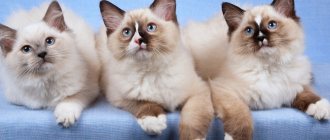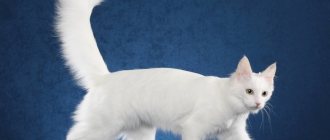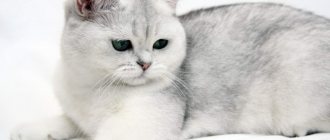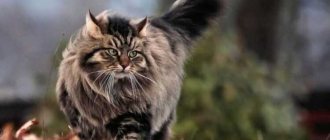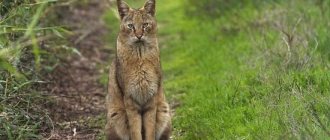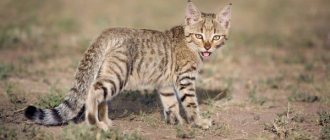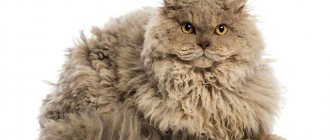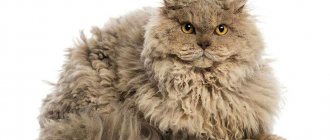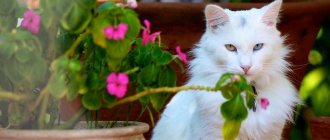Shorthair cats of British and Scottish origin are two related breeds, between which matings were allowed until the 2000s, and kittens were officially recognized.
But the final adoption of standards and international recognition of both breeds put an end to the debate about whether British folds exist.
Story
There is every reason to believe that the ancestors of our today's hero were Roman cats. Together with the legionnaires, they arrived on ships in Great Britain and conquered this country. Fold-eared Britons in the form in which we fell in love with these cute creatures appeared only in the nineteenth century. It was during this period that many experiments were carried out to create new breeds or change existing ones.
In order to get such amazing plush fur , the idea arose to cross a Scottish cat with a Persian cat. The result is known to you and me. Fans of the cat family, especially furry representatives, have probably already admired the lovely creature. But why did the black color appear? There are reasons for this too. The fact is that the British believe that it is black cats that attract good luck to the house.
Shorthair
Black shorthaired British cats and cats, as befits the breed, have a large body, a large head, a cute face with wide-set round eyes, as well as dense and water-repellent fur, but not soft, velvety, but rather harsh, giving off an anthracite shine. This gives a mystical mystery and bewitching appeal.
Coal Britons, affectionate but independent animals, easily tolerate loneliness. They can find entertainment themselves in the form of a toy or their own tail. They are clean, from childhood they are accustomed to the toilet and other rules of behavior in the house. They are distinguished by intelligence and intelligence.
They quickly get used to their owner and remain loyal. It is believed that such cats relieve tension with affection and purring, and help with pain and hypertension. They treat strangers with caution and keep their distance.
Description of the breed
The appearance of the fold is unusual for an ordinary cat, primarily due to the shape of the ears .
- The ears are widely spaced on the slightly flattened head and seem to be tucked downwards.
- The eyes are set close to the nose and have a rounded forum. Eye color is most often brown, gold or sand.
- The nose is small, with a small hump and also has a black color.
- The body is proportional, not stretched, compact. Despite their toy appearance, these are strong animals, dexterous, fast and very agile. Paws are straight, covered with hair. The pads are soft and have fur on them that should be trimmed periodically.
- The head is slightly flattened, but in proportion to the body. Visually they appear clubfooted, but this does not in any way affect the dexterity of the animal.
- The British belong to the category of large cats, so the maximum weight for them is about ten kilograms.
- The coat is short, but very thick, which creates a fluffy or even plush effect.
Apart from color, black representatives of Scottish Folds are no different from their fellow tribesmen of other colors.
To read: Features of the Corgi Fluffy breed, reviews from owners
Origin of color
It is believed that Roman conquerors or French sailors brought cats to the English Isles back in the 23rd century. They quickly multiplied in a semi-wild manner. The English breeder and felinologist Harrison Wyer began breeding monochromatic, solid cats of a purely British breed. With hard work, mating animals, he got black, red, and chocolate colors. This is how it was obtained and recognized in 1898 as an independent British cat breed.
The British black color of cats depends on the number of pigment granules, melanin and genes in each cell of the coat.
Melanin, which makes up Black color, is divided into two chemical varieties:
- Eumelanin, it contains dominant genes: “B” is responsible for the black pigment, and “C” and “D” give color intensity.
- Pheomelanin with diluting gene "A".
The fur of such a cat contains more closely pressed microscopic granules of pigment, so it feels harder and more elastic to the touch. Unlike other types of Britons, they cannot be called smooth like velvet.
Description of external features
Black solids for their brilliant anthracite color, with a harsh coat that does not resemble velvet, are recognized as leaders at all world exhibitions. In terms of beauty and effectiveness, close attention and primacy are given, but when selecting, judges apply strict criteria.
The characteristics of British black cats according to the standard include:
- Body: characterized by a straight back of medium size, with a wide chest, dense torso.
- Body: massive, squat due to short limbs, with voluminous hips.
- Head: Large, rounded in outline with characteristically thick, slightly drooping cheeks, between which is a short, straight nose of a basic color.
- Neck: compressed with the usual British rim, thick fold.
- Muzzle: Well arched with prominent whisker pads.
- Ears: small with slightly rounded tips, set wide relative to the nose, high on the forehead.
- Limbs: short, thick, but strong. The front paws have 5 toes, the hind paws have 4. The pads are the main color.
- Tail: Medium length, cone-shaped with a rounded tip.
- Coat: with an anthracite sheen, slightly harsh, with a dense undercoat. Each hair is painted with the main color from the tip of the tail to the ears; for purebred cats, spots, unpainted areas, inclusions are considered defective.
Eye color
Adult solidids have large, rounded eye sockets that are set wide apart from the nose. The final color of the iris is established late, in a one-year-old kitten. At first, blacklings are born with blue eyes, but from 6 months they begin to transform. In mature individuals, the eyes become yellow, or copper, orange, which is considered valuable.
Meeting a purebred coal Briton with blue or green eyes is not allowed by the standard.
Character
Just because your pet doesn't run to the door to greet you doesn't mean he's not attached to you. It's just that the British understanding of love and friendship is somewhat different from the affection and loyalty of dogs. They seem to be on their own, but at the same time they desperately need your attention and care. The lop-eared dog will not impose itself, but if you notice that it has perched itself next to you, do not be lazy and pet it. He will be endlessly pleased.
These cats are completely non-aggressive , but they will stand up for themselves without hesitation. They are patient with children, but their patience has narrow limits. Therefore, you should not persistently squeeze or invade the animal’s personal space. You are not purchasing a toy for your child, but a living being with its own character, ambitions and desires.
The Briton gets along easily with other cats , although he will try to take a dominant position, and if he doesn’t succeed, he will simply act independently and aloof. With dogs, they can behave aggressively and hit the cheeks if they feel that they are being harassed or try to attack.
The furry nature of lop-eared animals is aimed at the instinctive desire to protect themselves. If the animal feels completely safe, feels love and at the same time the boundaries of what is permitted, then you will not be overjoyed to have this sweetest creature in your home. He will only delight and amuse you .
Fold
Initially, such cats were brought to Scotland from China. The animals settled on the island, and by the middle of the 19th century they began to be considered a Scottish Fold breed. The name was given due to the characteristic feature of the construction of the auricle, the tips of which are slightly bent forward, which gives the muzzle an unusual appearance.
The Scots have a strong, well-formed body, with a large head, a powerful chin and strong jaws, with plump cheeks. Breeders gave the name to this type of cat appearance - cobby.
Breeders tried unsuccessfully to mate a thoroughbred British male with a Scottish Fold. When such individuals were brought to Russia in the 90s, Russian breeders tried to breed a new breed of British fold cats. The resulting appearance of the British, including black ones, was distinguished by the characteristic feature of slightly drooping ear tips on a large round head on a massive body. The fur of the British remained short, filled with undercoat. The crossing experiment was unsuccessful; the kittens were born with weak musculoskeletal function and other genetic diseases.
International felinological organizations did not recognize the new breed of British Fold, and since 2004 mating of Scottish Folds with British dogs has been prohibited.
Maintenance and care
The lop-eared Scot will not cause you any trouble. Caring for him is practically no different from caring for other cats. You will be required to keep up to date with all vaccinations as advised by your veterinarian. Visit your veterinarian about once every six months for a general checkup. Pay attention to the condition of your ears, eyes and nose. The nose should always be cold and wet.
Grooming the coat won't be too difficult either. You will need to regularly comb the animal with a soft brush, especially during the molting period, clean it from dirt and disinfect it from insect pests. Do not try to bathe your pet; these procedures may be harmful to him.
Do this only when there is a real need. For example, if the animal is very dirty. Scheduled bathing can be carried out no more than once every six months. Make sure that the water temperature does not exceed forty degrees, and that there are no drafts in the room. The British are prone to colds, which are very difficult to tolerate.
To read: Mysterious domestic Maine Coon lynxes: features of the breed, character of cats, care tips
Cats' diet should be balanced and nutritious. Premium dry food is best. If you want to cook for your pet yourself, then the best food for him is raw or boiled meat. Be sure to provide grains and vegetables. Do not serve food from the refrigerator; it must be heated.
Grooming
The black and black-and-white coats of Scottish Fold cats are resistant to color fading. It is not affected even by direct sunlight, which in other cases discolors the color or gives it an extraneous tint. The black color enhances the strength of the hair, which also has a positive effect on the quality of the coat and its appearance.
Hygiene for black fold cats comes down to regular brushing and keeping the mucous membranes clean.
- In normal times, it is enough to treat the wool twice a week. It is advisable to accustom black fold kittens to this procedure from childhood, so that in the future they do not perceive combing as a punishment.
- The active period of shedding makes it necessary to use a comb daily, and for semi-long-haired Scottish Fold black and white Highland Folds - several times a day.
- The nose and area around the eyes are cleaned as they become dirty.
- Ear hygiene. Care must be taken not to damage weak cartilages. Veterinarians also recommend using special drops and lotions that neutralize wax deposits in the ear canal.
Price
Purebred kittens with documents and a decent pedigree cost about ten thousand rubles. There are many advertisements on the Internet in which they are willing to give you a kitten even for a thousand rubles, but no one can guarantee that you are buying a truly purebred animal. Just like no one will give you documents.
Therefore, we can say that the price depends on what exactly you want to purchase. If you only need a cat with the appearance of a Scottish Fold, then you can look through advertisements on the Internet. But if the breed and its purebredness are important to you, then it is best to go directly to the nursery.
Pure Scottish blood
So, the inheritance of drooping ears occurs according to a dominant type, while straight ears are a recessive (suppressed) trait.
Purebred Scottish Folds are never born from the union of two fold-eared parents. To keep cats healthy, homozygous dominant crossbreeding is prohibited by the breed standard and breeding regulations.
Since fold-eared kittens are usually more in demand, breeders try to combine straights and folds. The probability of folds being born is 25%. In fact, if you're lucky, all the kittens in the litter may well turn out to be fold-eared.
Hygiene of floppy ears
No matter what the babies are called when they are sold: Scottish Folds or British Fold kittens, caring for them is the same:
- The ears must be examined daily and the appearance of diaper rash, odor, peeling or discharge from the ear canal must be noticed in time. The nature of the discharge usually clearly indicates existing problems;
- Once every few days (the regimen is selected individually), the auricle should be cleaned using prophylactic lotion and a cotton pad. It is advisable not to use cotton swabs and matches with cotton wool;
- Once a month, treat your cat for ticks and external parasites to avoid infection.
Fold-eared cats cope with washing and cleaning no worse than others, but are still sometimes unable to deal with the effects of heat, cold, and air humidity on their vulnerable ears. Sometimes purebred pets need help taking care of themselves.
Among specialists and resources with a good reputation, you can only find a discussion on the topic “British Fold cat: description of the breed” in the historical information section.
In the modern felinological community, such a breed does not exist! And when asked whether there are British kittens with floppy ears, you will hear a definite “no”.
Reviews
Some owner reviews:
- “I fell in love at first sight. Our Vaska is a very beautiful cat, and prone to narcissism. He can sit in front of the mirror for an hour and look at himself. There are no problems with him. Sometimes he confuses a scratching post with a sofa, and his toys with my books.”
- “When our son was born, we had to take Jason to his parents in the village. The cat constantly hissed at the baby, which did not stop him and the child continued to climb towards the cat. In the end, the inevitable happened - our son was scratched all over, and the cat moved away from us.”
Breeding
For experienced breeders, it is difficult to be sure that the offspring from each mating will produce a quality litter of black kittens. It is impossible to predict the result for objective and subjective reasons. It all depends on how the pairs are chosen correctly, which must meet the following conditions:
- Both parents are purebred black British, without flaws in the coat.
- When one of the applicants is prepotent, he will pass on the necessary genes to his offspring.
- When testing blood groups, A and B should not be combined in a pair, otherwise offspring may be born but will not survive.
- This is not the first time a cat and a cat have participated in mating. Early matings are contraindicated; the body of young kittens is not ready to reproduce healthy offspring.
- Genetic signs of heredity are traced through the pedigrees of the couple. If earlier in the litters there were babies that violated the standard, were colorful, with splashes, then the result of obtaining pure black kittens is not guaranteed.
- The couple undergoes a health examination from a veterinarian and preventive treatment against helminth infection.
- Be vaccinated at least a month before mating.
Black kittens
Breeders are not always able to obtain anthracite babies, even if the conditions for mating black solids are met. Kittens do not immediately become charcoal. A newborn's coat is gray or brown, but only after 8 months does it take on an adult color. To the chagrin of breeders, kittens do not always acquire a perfectly even anthracite tone. Another test awaits the black color. With complete loss of baby teeth in kittens, during puberty, coal solids can radically change the color of the coat.
Who is the color suitable for?
Many owners are attracted to the black pet because of its mystery and mystery. The owner, purchasing a coal kitten for his home, receives a devoted, affectionate friend for many years. These are independent, balanced, clean animals suitable for large families with small children. Good-natured until old age, they gladly participate in children's fun. For a frequently busy owner, such a cat is simply luck; he takes loneliness calmly and will not get bored, act up and climb on tables. Affectionate and sociable, the black British Shorthair cat has incredible positive energy.
Pros and cons of color
The lucky owners consider coal beauties simply ideal animals; they find many advantages in their behavior and manners:
- They rarely get sick and are carriers of immunity.
- They are affectionate towards their owner and remain loyal.
- Long-lived, sometimes up to 20 years.
- Independent, do not require much attention.
- They are clean, behave intelligently, do not misbehave, and are not vindictive.
- It has been observed that communication with them has a beneficial effect on health:
- For those suffering from hypertension;
- For people with heart disease;
- Relieves stress, absorbs negative energy accumulated during the day.
There are practically no negative traits in the behavior of handsome black men; the shortcomings are only in disqualifying vices. You can buy a kitten for a high price, which, having matured, will not retain the purebred characteristics of a black British cat.
Interesting facts about the British cat breed
Descriptions in ancient books and images in paintings indicate that the first British cats were not fold-eared:
- The Gospel from Lindisfarne (7th century) contains an image of a cat that is very similar to the modern Briton.
- The Book of Columba, a recognized handwritten masterpiece of the Irish monks, also contains illustrations of straight-eared cats.
Artists and sculptors depicted them to pay tribute to the beauty and grace of these animals. The monks wrote in poems that the life of hermits becomes more interesting and fun if a cat lives nearby. She was the only pet that was allowed to live on the territory of nunneries.
This is interesting! England became the first country to pass a cat protection law. In 936, the English prince Howell Dda issued a decree prohibiting any violence against these animals.
Appearance
The British Fold cat breed has similarities with other breeds. And they are often confused. In order not to be confused about what kind of cat you want to see with curled ears, we suggest you find out the appearance of the breed and the differences with others. This breed has many colors, currently there are 182 of them . The classic color remains - blue, or to be more precise - light blue. Among the rest of the British who were crossed with exotic representatives of this species of animals, we can highlight:
- black;
- lilac;
- chocolate;
- cream;
- white;
- bicolor;
- tabby (a characteristic feature of the “M” breed);
- tortoiseshell color;
- chinchilla color;
- Red.
© shutterstock
Peculiarities
Representatives of the British Fold breed have a unique body structure. A wide, straight nose is located under a flat forehead. The head is round in shape. Drooping ears (low-eared). Short legs and rounded paws. In combination with short and thick fur, the cat looks like a plush toy .
The difference by gender is visible to the naked eye. British cats are much larger than cats; they are large and muscular. Yes, and it’s noticeable from the face. While cats, although big-boned, are small, squat, and their facial expression can be called “maternal.”
Controversial issues
The British Fold is a rather controversial cat breed. And the dispute lies in the very shape of the ears. British cats have straight ears, but not fold ears . Straight, rounded and erect ears are characteristic of this breed. At that time, they could be confused with Scottish cats. Since this breed has 2 types of ears, one of which is straight ears.
The British paws look more massive due to their length. The cat's head is round, has large saggy cheeks and clearly defined cheekbones. The English cat is distinguished by its rounded tail.
Scottish Straight © shutterstock
Table: advantages and disadvantages of British and Scottish cats
| Advantages. | Flaws. |
|
|
Sources
- https://litbro.ru/porody-koshek/britanskaya-vislouhaya-koshka/kot-vislouhij-britanets
- https://MrKot.com/britanskaya-vislouhaya
- https://vsekotiki.ru/porody-koshek/britanskaya-vislouhaya-koshka
- https://kot-koshka.ru/britanskie-vislouhie-koshki
- https://MoiKoty.ru/porody/britanskie/vislouhij
- https://4lapy.ru/articles/shotlandskaya-poroda-koshki/
- https://prohvost.club/koshki/porody-koshek/britanets-vislouhiy-foto.html
[collapse]
Health and vaccination
Fold-eared “Britons” are at risk for genetic pathologies. This is due to the fact that they are descendants of two closely related breeds, one of which carries the gene for lop ears. This gene not only makes the ears original, but can also cause serious pathologies of the skeleton and bone tissue.
IMPORTANT! In kittens born from two lop-eared individuals, osteochondrodysplasia is inevitable - an incurable deformation of the joints. Therefore, fold-eared pets are crossed only with straight-eared ones.
Fold-eared “British” dogs are also susceptible to:
- hearing loss;
- respiratory viral infections;
- claw fungus;
- helminthiasis;
- flea infestation;
- disruption of the heart;
- the appearance of renal cysts.
For preventive maintenance, your pet needs to be shown to a veterinarian annually and vaccinated. Each vaccine is administered according to the time limits established by the veterinarian. Vaccination helps protect your pet from panleukopenia, rabies, and respiratory infections.
A healthy and well-groomed British Fold cat lives about 15 years.
Health, reproduction, kittens
British Folds were created through crossbreeding, so they can be quite sickly.
In particular, they have a high risk of developing the following pathologies:
- Deformation of cartilage in some individuals affects not only the shape of the ears, but also the entire spine. Therefore, they may experience fusion of the vertebrae, shortening of bones and thickening of joints, and the appearance of bone growths, which can only be corrected surgically.
- Hypertrophic cardiomyopathy (HCM) is a genetically determined uneven thickening of the interventricular septum and ventricular walls. Progresses to heart failure with chest pain. The disease makes itself felt in individuals after a year and is detected by ultrasound.
- Obesity. Due to a good appetite, if you do not monitor your pet’s nutrition and activity, it can gain excess weight quite quickly. This in turn will lead to many health problems. A proper diet, outdoor games and plenty of space in the house or yard increases his activity and reduces the risk of illness.
- Worms, fleas and other parasites come from the outside, are absorbed with food or hairballs when licking, especially if the cat is in contact with other animals. Now there are many means to get rid of them, which are best used as prescribed by a veterinarian.
- Infectious diseases. These are immunodeficiency, aspergillosis with chronic runny nose, calcivirosis and rhinotracheitis. And especially life-threatening peritonitis, panleukopenia, leukemia, rabies, tuberculosis. To prevent them, vaccinations are necessary: annual against rabies starting from the age of 8 months, and others no later than the three-year period when maternal immunity is still in effect.
On average, adults live from 14 to 20 years if you monitor their condition.
For example, periodically lifting an animal by its front legs reduces the likelihood of developing spinal pathologies. Timely and proper care will avoid many other problems.
Particular attention should be paid to the issue of breeding pets. If owners want to get healthy offspring, under no circumstances should individuals with the same gene be crossed when both of them have drooping ears.
It is worth taking individuals with straight and curved ears, it is better if both of them belong to the British breed. And after 9 weeks it will be possible to get a mixed litter, but the likelihood of their mutation is significantly reduced.
We recommend reading: Brazilian Bulldog (Campeiro) - description of the breed
The peculiarity of lop-eared cats is that they are all born with erect ears. They acquire their shape only on the 21st day, then it will be clear which of the babies will be straight-eared and which will be a typical representative of the British breed.
The owners will only have to choose suitable nicknames, remembering that the British are proud and independent animals, and they will serve their family faithfully.
Pitfalls - hereditary diseases of the British
Unfortunately, when buying a kitten, you may encounter the development of hereditary diseases. Experienced breeders monitor the manifestations of each disease, eliminate the defective gene in a timely manner, achieving healthy offspring, which cannot be said about amateurs who cross a cat with a similar cat.
Illiterate mating between a British and a Scot can lead to various diseases in the offspring, even if the mother and father are completely healthy. The most common problem is improper formation of the skeleton. As a rule, these are deformations of the spine and toe bones.
Growths may form on the bones of the paws, it becomes difficult for the animal to walk, and it becomes lame. Help consists of surgery and removal of bone growths. In some cases, heart disease develops, which usually appears after a year. To diagnose the disease at the initial stage, it is worth conducting an ultrasound of the heart annually.
If you are lucky enough to acquire a healthy kitten, most likely it will have a typical British disposition. He will be calm, balanced, love sleep and food. In childhood, the animal may be naughty, but in the future it becomes more and more lazy.
